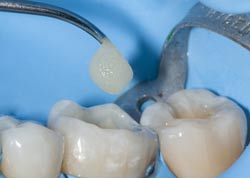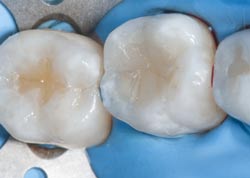Back to BisDent Globe Articles
REVEAL HD Bulk: Single Layer Composite Technique
Johan Figueira, DDS
Based in Los Angeles, CA / USA
Private Practice in Mexico & Venezuela
John Monges, DDS
Private Practice in Venezuela
Early advances in resin-based materials broadened their use to direct posterior restorations. Conventional composite resin restorations (designed to be placed in 2mm increments) are subject to problems associated with polymerization contraction, which may generate microfiltration, air trapped between layers, cuspal deflection & secondary caries. BISCO’s REVEAL® HD Bulk can be cured in 5-6 mm increments and addresses many of the issues commonly presented with conventional resin materials.
Bulk-fill composite materials are characterized as having a lower shrinkage stress and a higher depth of cure than conventional composites. Shrinkage stress is defined as the amount of force per area exerted on the walls of a cavity preparation by a composite as it polymerizes. Depth of cure is commonly measured by examining the hardness or the degree of double-bond conversion at the surface of a composite exposed to a curing light and comparing it with the degree of conversion at various depths of the restoration.
When a composite is light cured from the occlusal surface, light energy from the curing light must be transmitted through the entirety of the composite without being absorbed or deflected before reaching the bottom of the restoration. By adjusting the translucency of the composite or matching the refractive index of the filler and the resin, light can travel through an increased depth of a bulk-filled composite.
In this particular case, placing Reveal HD Bulk in a 5mm increment reduced clinical time significantly, and achieved the ideal adaptation to the cavity walls due to the fluidity of the material. Reveal HD Bulk allows you to shape the occlusal anatomy and offers the desired esthetics for the final restoration.

Figure 1
Pre-operative photo

Figure 2
Excavation of carious lesions (#18) and existing composite w/ recurrent decay (#19)

Figure 3
Phosphoric acid w/ BAC (total etch technique #18, selective etch technique #19)

Figure 4
Application of All-Bond Universal

Figure 5
Placement of REVEAL HD Bulk in 5mm increments.

Figure 6
Immediate post operative photo
Learn more about REVEAL HD Bulk...
Fall 2017 BisDent Globe, Volume XXI1I, Issue II
Back to BisDent Globe Articles